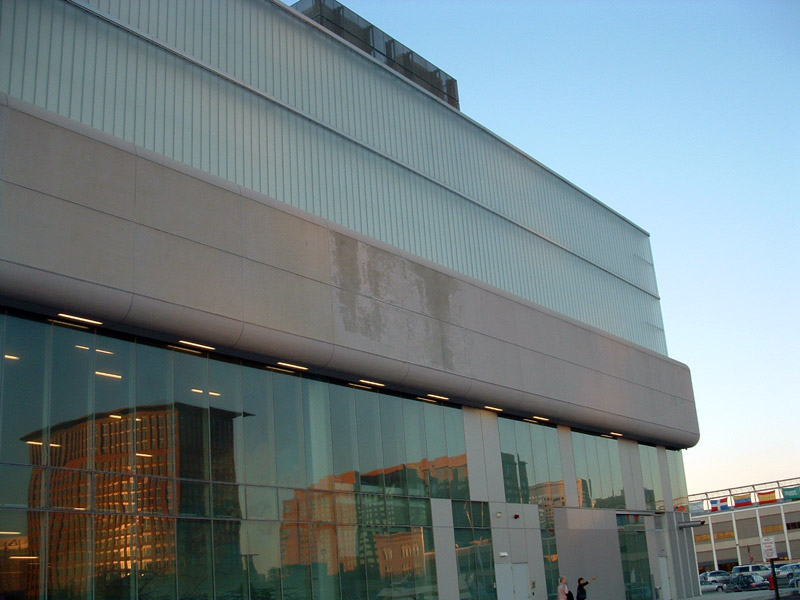Globe interview with Elizabeth of Diller+Scofidio
From this Sunday's Ideas section:
Q&A with Elizabeth Diller
By Harvey Blume | February 18, 2007
Elizabeth Diller, of the architecture firm Diller, Scofidio + Renfro, is known in Boston for her role in designing the new home of the Institute of Contemporary Art on Boston Harbor. But in keeping with Diller's refusal to sharply divide art from architecture, the building does more than admirably house and showcase contemporary art; it also exemplifies it.
When I met with Diller last week in her office in Manhattan's Chelsea neighborhood, she said that residents of Boston -- "a traditional city, a brick city" -- struck her from the first as "hungry for a piece of contemporary architecture." With its large, cantilevered gallery space, the new ICA delivers handsomely on that score. But Diller wanted to give the building another dimension, encouraging museum-goers "to look a little bit at looking itself."
The ICA accomplishes that with varied, carefully modulated views of Boston Harbor, which make it difficult not to ask where the art ends and the world -- in this case a water world -- begins. And that is exactly the sort of question many artists in the last century have specialized in putting forward.
Diller's blurring of distinctions between art and architecture has occasioned resentment from architects. "Professional jealousy" came to the fore, she told me, when she and her husband Ricardo Scofidio won MacArthur "genius" grants in 1999, the first architects to do so. Colleagues muttered about the couple getting that kind of recognition: Hadn't Diller and Scofidio mostly been involved with installation art, dance pieces, theater, and film, all of which may have explored issues of space and human interaction but couldn't be considered architecture per se?
That question, however, if it was ever plausible, is now moot. The ICA is widely praised, and Elizabeth Diller and company have taken on a number of high profile projects in New York City, including the redesign of Lincoln Center, which is underway, and the transformation of the High Line -- an abandoned, elevated railroad in Chelsea -- into a park.
IDEAS: What's the difference between working in New York and working in Boston?
DILLER: Some of the work we're doing in New York City right now -- Lincoln Center, the High Line -- has historical significance particular to New York. In Boston we were privileged to be on the edge, in a development not yet built. That gave us enormous freedom.
IDEAS: Does being involved in high profile architecture mean you'll be doing less of the kind of art you're known for?
DILLER: Not at all. We have a whole division here for money-losing projects, and someone in charge of it.
We've recently collaborated on a theater piece called "Who's Your Dada?" and finished work with a French filmmaker. It's what we need to do to survive. Our practice is a research practice. Occasionally we get a chance to realize our researches in real life, in public space.
IDEAS: But you have run into some severe criticism, haven't you, from both the art world and architects.
DILLER: There is a kind of disciplinary border control at work here. There are those who think that people like us ought to pick one discipline, architecture or art. When we had a show at the Whitney Museum ["Scanning: The Aberrant Architectures of Diller & Scofidio," 2003] some critics were infuriated that architects like us were traveling in the art world. They couldn't imagine us as architects who were interested in space, and in showing how art and architecture can overlap.
IDEAS: But don't you acknowledge a difference between having a show at the Whitney Museum, say, and building the ICA or redesigning Lincoln Center?
DILLER: Of course it's different. Each project, each site has different limitations and a different history. We start every project by exploring the history. For example, we started Lincoln Center by looking at when it was built. What we do will be a bit of a commentary on its history.
IDEAS: It was built under Robert Moses, right?
DILLER: Right, in the late 1950s, early 1960s. Lincoln Center demolished block after block to be built, displacing thousands of families and businesses. It was regarded as almost an enemy of the people, an Acropolian structure elevating the arts and freezing the public out.
IDEAS: New Yorkers don't see it that way now.
DILLER: But that is its history. Lincoln Center pushed the public out, censoring out the public that lived nearby, and inviting only a certain clientele. It has generated all this development around it since, so now you see fancy towers and private condos in that area.
IDEAS: All very elite.
DILLER: Exactly. Lincoln Center produced an expansion of its elitism in the development around it.
But now when you look at Lincoln Center it actually seems a lower scale thing, a sanctuary in the middle of all these huge condos. Our aim is to help democratize it, letting the general public in, and sending a message to the city to that effect.
IDEAS: How will you do it?
DILLER: By eroding its edges. It's built almost like a fortress with a solid base all the way around it. Most of the periphery is about service, either garage entries or loading docks. We're turning it inside out, assisting an historic reversal.
IDEAS: What do you intend to do with the High Line?
DILLER: In a sense, our role as architects is to protect it from architecture.
In the decades since the High Line was used as an industrial railroad, all these ecosystems have grown up on it, evolving from air blown seed, or seeds that had come in on the wheels of trains. Rudolph Giuliani wanted to demolish the High Line. But now that people know it's going to be saved, developers are coming like a pack of wolves. We want to preserve some of the High Line's rawness.
IDEAS: When you started out, people like you and Ricardo Scofidio, with art world backgrounds, didn't actually get to build buildings, did you?
DILLER: Very true. When we began in the early '80s, architects couldn't build because there was a recession. Some interesting architectural thinkers chose to express themselves on paper, either in print or on gallery walls. That was considered paper architecture.
We were different in that we really wanted to realize our work in a public realm, even if it had short duration. Sometimes we stole or borrowed sites. Sometimes we were invited to do work in galleries.
IDEAS: What's changed so that you get backing to actually build?
DILLER: In New York City, there is a really unusual administration -- a pro-active mayor who thinks big, and a progressive set of minds ushering in a lot of interesting projects. As luck would have it, we are the beneficiaries.
IDEAS: And in Boston? How did you get a major new museum off the ground?
DILLER: When Jill Medvedow became director in 1998, the ICA was very close to closing its doors, and not necessarily for lack of good shows. But Jill's an activist by nature. She really knew how to step in, expand the board, and raise money. Boston does not have a huge contemporary art patronage, though there's no shortage of patrons for the ballet or the Museum of Fine Arts. But Jill was able to get enthusiastic younger members on the board who got their friends involved. She was charming and passionate, and able to convince a lot of people.
IDEAS: So leadership counts. Will you be doing more work in Boston?
DILLER: We made a lot of friends in Boston, and hope more work will evolve. And we're forever connected to the ICA at the hip.
Harvey Blume is a writer based in Cambridge. His interviews appear regularly in Ideas. E-mail hblume@world.std.com.
? Copyright 2007 Globe Newspaper Company.
From this Sunday's Ideas section:
Q&A with Elizabeth Diller
By Harvey Blume | February 18, 2007
Elizabeth Diller, of the architecture firm Diller, Scofidio + Renfro, is known in Boston for her role in designing the new home of the Institute of Contemporary Art on Boston Harbor. But in keeping with Diller's refusal to sharply divide art from architecture, the building does more than admirably house and showcase contemporary art; it also exemplifies it.
When I met with Diller last week in her office in Manhattan's Chelsea neighborhood, she said that residents of Boston -- "a traditional city, a brick city" -- struck her from the first as "hungry for a piece of contemporary architecture." With its large, cantilevered gallery space, the new ICA delivers handsomely on that score. But Diller wanted to give the building another dimension, encouraging museum-goers "to look a little bit at looking itself."
The ICA accomplishes that with varied, carefully modulated views of Boston Harbor, which make it difficult not to ask where the art ends and the world -- in this case a water world -- begins. And that is exactly the sort of question many artists in the last century have specialized in putting forward.
Diller's blurring of distinctions between art and architecture has occasioned resentment from architects. "Professional jealousy" came to the fore, she told me, when she and her husband Ricardo Scofidio won MacArthur "genius" grants in 1999, the first architects to do so. Colleagues muttered about the couple getting that kind of recognition: Hadn't Diller and Scofidio mostly been involved with installation art, dance pieces, theater, and film, all of which may have explored issues of space and human interaction but couldn't be considered architecture per se?
That question, however, if it was ever plausible, is now moot. The ICA is widely praised, and Elizabeth Diller and company have taken on a number of high profile projects in New York City, including the redesign of Lincoln Center, which is underway, and the transformation of the High Line -- an abandoned, elevated railroad in Chelsea -- into a park.
IDEAS: What's the difference between working in New York and working in Boston?
DILLER: Some of the work we're doing in New York City right now -- Lincoln Center, the High Line -- has historical significance particular to New York. In Boston we were privileged to be on the edge, in a development not yet built. That gave us enormous freedom.
IDEAS: Does being involved in high profile architecture mean you'll be doing less of the kind of art you're known for?
DILLER: Not at all. We have a whole division here for money-losing projects, and someone in charge of it.
We've recently collaborated on a theater piece called "Who's Your Dada?" and finished work with a French filmmaker. It's what we need to do to survive. Our practice is a research practice. Occasionally we get a chance to realize our researches in real life, in public space.
IDEAS: But you have run into some severe criticism, haven't you, from both the art world and architects.
DILLER: There is a kind of disciplinary border control at work here. There are those who think that people like us ought to pick one discipline, architecture or art. When we had a show at the Whitney Museum ["Scanning: The Aberrant Architectures of Diller & Scofidio," 2003] some critics were infuriated that architects like us were traveling in the art world. They couldn't imagine us as architects who were interested in space, and in showing how art and architecture can overlap.
IDEAS: But don't you acknowledge a difference between having a show at the Whitney Museum, say, and building the ICA or redesigning Lincoln Center?
DILLER: Of course it's different. Each project, each site has different limitations and a different history. We start every project by exploring the history. For example, we started Lincoln Center by looking at when it was built. What we do will be a bit of a commentary on its history.
IDEAS: It was built under Robert Moses, right?
DILLER: Right, in the late 1950s, early 1960s. Lincoln Center demolished block after block to be built, displacing thousands of families and businesses. It was regarded as almost an enemy of the people, an Acropolian structure elevating the arts and freezing the public out.
IDEAS: New Yorkers don't see it that way now.
DILLER: But that is its history. Lincoln Center pushed the public out, censoring out the public that lived nearby, and inviting only a certain clientele. It has generated all this development around it since, so now you see fancy towers and private condos in that area.
IDEAS: All very elite.
DILLER: Exactly. Lincoln Center produced an expansion of its elitism in the development around it.
But now when you look at Lincoln Center it actually seems a lower scale thing, a sanctuary in the middle of all these huge condos. Our aim is to help democratize it, letting the general public in, and sending a message to the city to that effect.
IDEAS: How will you do it?
DILLER: By eroding its edges. It's built almost like a fortress with a solid base all the way around it. Most of the periphery is about service, either garage entries or loading docks. We're turning it inside out, assisting an historic reversal.
IDEAS: What do you intend to do with the High Line?
DILLER: In a sense, our role as architects is to protect it from architecture.
In the decades since the High Line was used as an industrial railroad, all these ecosystems have grown up on it, evolving from air blown seed, or seeds that had come in on the wheels of trains. Rudolph Giuliani wanted to demolish the High Line. But now that people know it's going to be saved, developers are coming like a pack of wolves. We want to preserve some of the High Line's rawness.
IDEAS: When you started out, people like you and Ricardo Scofidio, with art world backgrounds, didn't actually get to build buildings, did you?
DILLER: Very true. When we began in the early '80s, architects couldn't build because there was a recession. Some interesting architectural thinkers chose to express themselves on paper, either in print or on gallery walls. That was considered paper architecture.
We were different in that we really wanted to realize our work in a public realm, even if it had short duration. Sometimes we stole or borrowed sites. Sometimes we were invited to do work in galleries.
IDEAS: What's changed so that you get backing to actually build?
DILLER: In New York City, there is a really unusual administration -- a pro-active mayor who thinks big, and a progressive set of minds ushering in a lot of interesting projects. As luck would have it, we are the beneficiaries.
IDEAS: And in Boston? How did you get a major new museum off the ground?
DILLER: When Jill Medvedow became director in 1998, the ICA was very close to closing its doors, and not necessarily for lack of good shows. But Jill's an activist by nature. She really knew how to step in, expand the board, and raise money. Boston does not have a huge contemporary art patronage, though there's no shortage of patrons for the ballet or the Museum of Fine Arts. But Jill was able to get enthusiastic younger members on the board who got their friends involved. She was charming and passionate, and able to convince a lot of people.
IDEAS: So leadership counts. Will you be doing more work in Boston?
DILLER: We made a lot of friends in Boston, and hope more work will evolve. And we're forever connected to the ICA at the hip.
Harvey Blume is a writer based in Cambridge. His interviews appear regularly in Ideas. E-mail hblume@world.std.com.
? Copyright 2007 Globe Newspaper Company.









